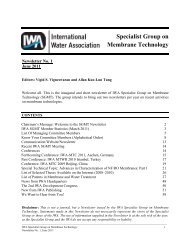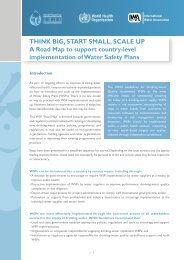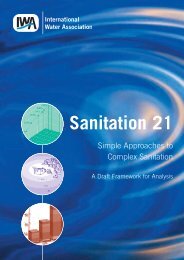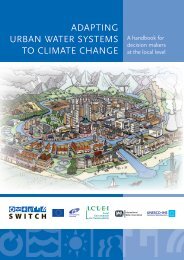Specialist Group on Use of Macrophytes in Water Pollution ... - IWA
Specialist Group on Use of Macrophytes in Water Pollution ... - IWA
Specialist Group on Use of Macrophytes in Water Pollution ... - IWA
Create successful ePaper yourself
Turn your PDF publications into a flip-book with our unique Google optimized e-Paper software.
NUTRIENT RELEASE FROM INTEGRATED CONSTRUCTED WETLANDS<br />
SEDIMENT<br />
Yu D<strong>on</strong>g 1 , Birol Kayranli 1 , Miklas Scholz 1,2 , Devi Prasad Tumula 2 and Rory Harr<strong>in</strong>gt<strong>on</strong> 3<br />
1 Institute for Infrastructure and Envir<strong>on</strong>ment, School <strong>of</strong> Eng<strong>in</strong>eer<strong>in</strong>g, The University <strong>of</strong><br />
Ed<strong>in</strong>burgh, William Rank<strong>in</strong>e Build<strong>in</strong>g, K<strong>in</strong>g’s Build<strong>in</strong>gs, EH9 3JL, Ed<strong>in</strong>burgh, UK<br />
2 Civil Eng<strong>in</strong>eer<strong>in</strong>g <str<strong>on</strong>g>Group</str<strong>on</strong>g>, School <strong>of</strong> Comput<strong>in</strong>g, Science and Eng<strong>in</strong>eer<strong>in</strong>g, The University <strong>of</strong><br />
Salford, Newt<strong>on</strong> Build<strong>in</strong>g, Salford M5 4WT, UK<br />
3 <strong>Water</strong> and Plann<strong>in</strong>g Divisi<strong>on</strong>, Department <strong>of</strong> Envir<strong>on</strong>ment, Heritage and Local Government,<br />
<strong>Water</strong>ford County Council, Ireland<br />
Email: y.d<strong>on</strong>g@ed.ac.uk<br />
INTRODUCTION<br />
Wetland sediments ma<strong>in</strong>ly comprise <strong>of</strong> organic matter from wastewater, dead plants and<br />
m<strong>in</strong>erals associated with soil erosi<strong>on</strong>. Sediment may reta<strong>in</strong> or release c<strong>on</strong>tam<strong>in</strong>ants when<br />
envir<strong>on</strong>mental c<strong>on</strong>diti<strong>on</strong>s change.<br />
METHODS<br />
Five horiz<strong>on</strong>tal free surface flow c<strong>on</strong>structed wetland mesocosms (Figure 1) were set up at<br />
The University <strong>of</strong> Ed<strong>in</strong>burgh to provide nutrient removal and/or accumulati<strong>on</strong> with<strong>in</strong><br />
<strong>in</strong>tegrated c<strong>on</strong>structed wetland (ICW) sediment. The laboratory room temperature was<br />
ma<strong>in</strong>ta<strong>in</strong>ed at 15 ºC. Artificial light was provided by programmable c<strong>on</strong>trolled UV lights to<br />
simulate diurnal sunsh<strong>in</strong>e. The mesocosms were c<strong>on</strong>structed us<strong>in</strong>g polyv<strong>in</strong>yl chloride<br />
dra<strong>in</strong>age pipes with identical dimensi<strong>on</strong>s (height: 83 cm; diameter: 10 cm). Seven plastic taps<br />
were evenly placed around the circumference <strong>of</strong> the pipe for subsequent sample collecti<strong>on</strong>.<br />
The outlet valves were located at the centre <strong>of</strong> the bottom plate for each pipe. Outflow water<br />
was collected with v<strong>in</strong>yl tub<strong>in</strong>g <strong>of</strong> 1.2 cm <strong>in</strong>ternal diameter.<br />
Of the five mesocosms (Figure 2), two were fed with farmyard run<strong>of</strong>f (mesocosms 1 and 2).<br />
Three mesocosms (mesocosms 3, 4 and 5) were fed with pre-treated domestic wastewater.<br />
Three planted experimental mesocosms (mesocosms 2, 3 and 4) were packed with four<br />
successive layers <strong>of</strong> aggregates (from bottom to top): 50 mm <strong>of</strong> small gravel (1.2–5.0 mm),<br />
50 mm <strong>of</strong> sand (0.6–1.2 mm), 250 mm <strong>of</strong> sodium bent<strong>on</strong>ite clay (permeability <strong>of</strong> 10 -9 m/s)<br />
and 350 mm <strong>of</strong> core sediment (<strong>in</strong>corporat<strong>in</strong>g plants if applicable). These systems were<br />
flooded with <strong>in</strong>flow water up to the top. Core sediment samples were directly taken from the<br />
surface <strong>of</strong> ICW site 11 (cell 1), which were applied for the treatment <strong>of</strong> farmyard run<strong>of</strong>f for<br />
approximate ten years (Figure 3a). Further core sediment samples <strong>of</strong> domestic mesocosms<br />
were extracted from the surface <strong>of</strong> ICW site 7 (cell 1), which were c<strong>on</strong>structed to treat<br />
domestic wastewater for approximate eight years (Figure 3b). Two c<strong>on</strong>trol mesocosms<br />
(mesocosms 1 and 5) were set up to ensure the same flow c<strong>on</strong>diti<strong>on</strong>s and saturati<strong>on</strong> ratios.<br />
The soils and aggregates <strong>of</strong> the two c<strong>on</strong>trol mesocosms (from bottom to top) c<strong>on</strong>ta<strong>in</strong>ed 50<br />
mm <strong>of</strong> small gavel (1.2–5.0 mm), 50 mm <strong>of</strong> sand (0.6–1.2 mm), and 600 mm <strong>of</strong> sodium<br />
bent<strong>on</strong>ite clay (permeability <strong>of</strong> 10 -9 m/s).<br />
____________________________________________________________________________________________________<br />
<strong>IWA</strong> <str<strong>on</strong>g>Specialist</str<strong>on</strong>g> <str<strong>on</strong>g>Group</str<strong>on</strong>g> <strong>on</strong> <strong>Use</strong> <strong>of</strong> <strong>Macrophytes</strong> <strong>in</strong> <strong>Water</strong> Polluti<strong>on</strong> C<strong>on</strong>trol: Newsletter No. 38 17

















